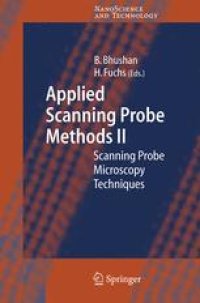
Ebook: Applied Scanning Probe Methods II: Scanning Probe Microscopy Techniques
Author: Robert W. Stark Martin Stark (auth.) Professor Bharat Bhushan Professor Dr. Harald Fuchs (eds.)
- Tags: Nanotechnology, Surfaces and Interfaces Thin Films, Polymer Sciences, Physical Chemistry, Solid State Physics and Spectroscopy, Analytical Chemistry
- Series: NanoScience and Technology
- Year: 2006
- Publisher: Springer-Verlag Berlin Heidelberg
- Edition: 1
- Language: English
- pdf
The Nobel Prize of 1986 on Sc- ningTunnelingMicroscopysignaled a new era in imaging. The sc- ning probes emerged as a new - strument for imaging with a p- cision suf?cient to delineate single atoms. At ?rst there were two – the Scanning Tunneling Microscope, or STM, and the Atomic Force Mic- scope, or AFM. The STM relies on electrons tunneling between tip and sample whereas the AFM depends on the force acting on the tip when it was placed near the sample. These were quickly followed by the M- netic Force Microscope, MFM, and the Electrostatic Force Microscope, EFM. The MFM will image a single magnetic bit with features as small as 10nm. With the EFM one can monitor the charge of a single electron. Prof. Paul Hansma at Santa Barbara opened the door even wider when he was able to image biological objects in aqueous environments. At this point the sluice gates were opened and a multitude of different instruments appeared. There are signi?cant differences between the Scanning Probe Microscopes or SPM, and others such as the Scanning Electron Microscope or SEM. The probe microscopes do not require preparation of the sample and they operate in ambient atmosphere, whereas, the SEM must operate in a vacuum environment and the sample must be cross-sectioned to expose the proper surface. However, the SEM can record 3D image and movies, features that are not available with the scanning probes.
Volumes II, III and IV examine the physical and technical foundation for recent progress in applied near-field scanning probe techniques, and build upon the first volume published in early 2004. The field is progressing so fast that there is a need for a second set of volumes to capture the latest developments. It constitutes a timely comprehensive overview of SPM applications, now that industrial applications span topographic and dynamical surface studies of thin-film semiconductors, polymers, paper, ceramics, and magnetic and biological materials. Volume II introduces scanning probe microscopy, including sensor technology, Volume III covers the whole range of characterization possibilities using SPM and Volume IV offers chapters on uses in various industrial applications. The international perspective offered in these three volumes - which belong together - contributes further to the evolution of SPM techniques.
Volumes II, III and IV examine the physical and technical foundation for recent progress in applied near-field scanning probe techniques, and build upon the first volume published in early 2004. The field is progressing so fast that there is a need for a second set of volumes to capture the latest developments. It constitutes a timely comprehensive overview of SPM applications, now that industrial applications span topographic and dynamical surface studies of thin-film semiconductors, polymers, paper, ceramics, and magnetic and biological materials. Volume II introduces scanning probe microscopy, including sensor technology, Volume III covers the whole range of characterization possibilities using SPM and Volume IV offers chapters on uses in various industrial applications. The international perspective offered in these three volumes - which belong together - contributes further to the evolution of SPM techniques.
Content:
Front Matter....Pages I-XLIII
Higher Harmonics in Dynamic Atomic Force Microscopy....Pages 1-36
Atomic Force Acoustic Microscopy....Pages 37-90
Scanning Ion Conductance Microscopy....Pages 91-119
Spin-Polarized Scanning Tunneling Microscopy....Pages 121-141
Dynamic Force Microscopy and Spectroscopy....Pages 143-164
Sensor Technology for Scanning Probe Microscopy and New Applications....Pages 165-203
Quantitative Nanomechanical Measurements in Biology....Pages 205-239
Scanning Microdeformation Microscopy: Subsurface Imaging and Measurement of Elastic Constants at Mesoscopic Scale....Pages 241-281
Electrostatic Force and Force Gradient Microscopy: Principles, Points of Interest and Application to Characterisation of Semiconductor Materials and Devices....Pages 283-320
Polarization-Modulation Techniques in Near-Field Optical Microscopy for Imaging of Polarization Anisotropy in Photonic Nanostructures....Pages 321-360
Focused Ion Beam as a Scanning Probe: Methods and Applications....Pages 361-412
Back Matter....Pages 413-420
Volumes II, III and IV examine the physical and technical foundation for recent progress in applied near-field scanning probe techniques, and build upon the first volume published in early 2004. The field is progressing so fast that there is a need for a second set of volumes to capture the latest developments. It constitutes a timely comprehensive overview of SPM applications, now that industrial applications span topographic and dynamical surface studies of thin-film semiconductors, polymers, paper, ceramics, and magnetic and biological materials. Volume II introduces scanning probe microscopy, including sensor technology, Volume III covers the whole range of characterization possibilities using SPM and Volume IV offers chapters on uses in various industrial applications. The international perspective offered in these three volumes - which belong together - contributes further to the evolution of SPM techniques.
Content:
Front Matter....Pages I-XLIII
Higher Harmonics in Dynamic Atomic Force Microscopy....Pages 1-36
Atomic Force Acoustic Microscopy....Pages 37-90
Scanning Ion Conductance Microscopy....Pages 91-119
Spin-Polarized Scanning Tunneling Microscopy....Pages 121-141
Dynamic Force Microscopy and Spectroscopy....Pages 143-164
Sensor Technology for Scanning Probe Microscopy and New Applications....Pages 165-203
Quantitative Nanomechanical Measurements in Biology....Pages 205-239
Scanning Microdeformation Microscopy: Subsurface Imaging and Measurement of Elastic Constants at Mesoscopic Scale....Pages 241-281
Electrostatic Force and Force Gradient Microscopy: Principles, Points of Interest and Application to Characterisation of Semiconductor Materials and Devices....Pages 283-320
Polarization-Modulation Techniques in Near-Field Optical Microscopy for Imaging of Polarization Anisotropy in Photonic Nanostructures....Pages 321-360
Focused Ion Beam as a Scanning Probe: Methods and Applications....Pages 361-412
Back Matter....Pages 413-420
....